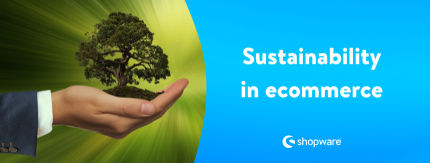
In this article, our partner LightsOn provides you with valuable tips on the subject of sustainability in ecommerce. What can your company do to reduce its carbon footprint, become more transparent, and get a little greener every day?
Content
1. The challenges of sustainability in ecommerce
2. Options for sustainable ecommerce
2.1 Areas of ecommerce where there is room for improvement
2.2 Solution approaches to above-mentioned problems
2.3 Additional options for establishing sustainable solutions in ecommerce
3. Conclusion: Sustainability in ecommerce as a growth process
1. The challenges of sustainability in ecommerce
In recent years, more attention has been paid to sustainable and resource-friendly commerce, including ecommerce. Consumers are placing increasing importance on purchasing sustainable products, and are often prepared to pay more for them. But not only the products themselves can be sustainable: your store, and the value chain attached to it, can also be redesigned or set up based on diverse sustainability criteria. This means that you're using sustainability as a USP, and you and your customers profit equally.
But what does sustainability even mean? It describes the way in which we use our planet's resources consciously, and as gently as possible. It aims to ensure that future generations are not put at risk by consumption and environmentally harmful behavior. It means that the environmental footprint of each individual should be minimized, and that our focus should be on climate goals.

Though electronic commerce scores higher than stationary retail in terms of sustainability, this doesn't mean improvements in this area are not needed. In the following, we have compiled various solution approaches for more sustainability in ecommerce, and listed the factors that are decisive for resource-friendly behavior by store operators.
2. Options for sustainable ecommerce
2.1 Areas of ecommerce where there is room for improvement
The major factors in ecommerce that have a negative environmental impact are in the areas of shipping and returns, packaging and waste production, as well as a lack or non-transparency of product offers that are really sustainable. Often an order is delivered in partial shipments, or large parts of the order are sent back. Poorly chosen product images or insufficient information, for example, can present a false impression of the products on offer, which results in more returns.

Products are frequently wrapped several times in packages that are too big, or in non-recyclable packages that are printed numerous times. In addition, sustainable products are often insufficiently marked and thus difficult to find in the store, or they cannot be easily differentiated from other products.
What can you do to attach the utmost importance to sustainability in your store? In the following, you'll find all the important information about the areas in which you can work toward making your online store sustainable.
2.2 Solution approaches to above-mentioned problems
Shipping
Shipping is a major factor when it comes to sustainability in ecommerce. Here there are various options for improvement:
Environmentally friendly shipping options:
The use of services such as DHL GoGreen – which deploys electric delivery vehicles – or the transport of goods by train rather than by air significantly reduces emissions. An additional option is to offer a carbon offset for the shipment, whereby customers pay a small additional fee that goes to climate protection projects. Shipping service providers such as DHL provide this option, for example.
The choice of delivery vehicles should, to the extent possible, be made with an eye to their climate friendliness – even though a longer delivery time is often the result. It's important to think "slow delivery": if there's more time for the delivery, the company can switch to more environmentally friendly alternatives. Companies that don't want to switch completely to slow delivery can at least offer their customers the option of waiting a bit longer for their shipment, thereby improving its environmental footprint.

In addition, providing customers with various delivery options reduces the effort made to deliver as well as delivery distances themselves. Agreed-upon delivery locations, or deliveries to a package shop, are advantageous and contribute to more sustainability in your store. Click & Collect can also contribute to sustainability if the same criteria as with shipping options are applied.
Transparent, sustainable supply chains:
When you create transparent supply chains – that is, disclose carbon emissions and working conditions – customers develop more understanding of the products' origin and fair trade conditions. This ensures you have a fairly produced product and increases your customers' trust in you. Products can be traced through QR codes that are enclosed in deliveries, for example.
Regionalism:
When individual products in your store are manufactured in Europe or even in Germany, this significantly shortens delivery routes. You should also make this apparent to your customers and highlight it in the communication in your store. Warehouse options near the customers allow them to pick up products, which eliminates long delivery routes.
One example is the German National Climate Initiative's encouragement of logistics solutions in the form of micro-depots (small, decentrally distributed depots). The organization suggests that as much of the final transport route to the recipient as possible should be covered by cargo bicycles or electric transport vehicles, so that the last part of the supply chain is as environmentally friendly as possible. This brings ecommerce closer to becoming sustainable.
Reduce returns:
A reduction in returns also contributes to environmentally friendly behavior. One way of avoiding returns is by describing the size and material of the product in as much detail as possible in your store and providing several accurate images. High return costs also lead customers to rethink whether they really want to return a product – or lead them to not order it in the first place with the intention of returning parts or the entire delivery.

Fewer shipments:
Avoid partial shipments by having products for individual buyers packed together, even if this could lengthen the delivery time. Alternately, you can inform your customers about the environmental impact and give them the option of avoiding partial deliveries.
Recommerce and refurbishing
A very important concept that contributes greatly to sustainability is reuse and refurbishing. There are unfortunately still companies that don't accept returns physically but have them destroyed after the goods are credited to the customer. A major goal should be to make the return process as easy as possible, for customers and within the company. This means that products are always sent back, whether they're new or used. These products can then undergo a refurbishment process and be resold for second use. Eventual repair services can also be part of the recommerce process.
Packaging and waste
The packaging of products that are shipped also has an impact on the environment, and thus determines whether your online store is sustainable. Here are a number of options for reducing your environmental footprint.

You save packages by consolidating partial shipments into a collective delivery.
Using packages in the appropriate size and avoiding extra filling material also helps reduce packaging waste. This also means shipping charges can partly be reduced and space can be saved in delivery vehicles.
Of course, it's also an advantage if you can avoid wrapping each product in a carton in plastic as well. This saves packaging within the delivery.
Moreover, enclosed printed return labels can be replaced with digital alternatives – for instance, barcodes that are sent by mail or provided in customer accounts. In addition to the paper, printer ink, and energy that are saved, customer returns can be much better coordinated by merchants online. Similarly, you can send accompanying advertising or informational flyers by email instead of placing them in packages.
Another method that is slowly becoming more accepted is the use of reusable packaging. This can be sent back to the online store, given to the mail carrier, or dropped off at a packing station. However, until realistic options exist, you can try to reuse the cartons as often as possible.
If you offer Click & Collect, you can avoid repackaging entirely.
Offer sustainable products and make them identifiable to customers
Many customers like to take advantage of sustainable alternatives and are prepared to pay more than for non-sustainable variants. This makes it even more vital that you label sustainable products and product lines as such, and make them visible to customers. Both the titles and the product descriptions should be adapted accordingly, and they should be visually marked as sustainable.

Of course, the price of the sustainable alternatives should not be artificially inflated, but should compensate for the extra costs within reasonable limits. Sustainable product offers naturally begin in the production phase. Thus, the use of sustainable materials such as organic cotton instead of polyester is an option in the textile industry, for example.
The production location also contributes to the sustainability of your products. For products to be sold in a European market, production within Europe would seem obvious. This reduces carbon emissions and gives companies the opportunity to personally monitor production sites.
Some criteria for sustainable products are:
Made in Germany (or Europe)
Organically farmed raw material
Production is resource-friendly and uses few pollutants
The products have a long "life expectancy"
and much more.
2.3 Additional options for establishing sustainable solutions in ecommerce
Sustainable technology management
Green coding:
With green coding, or sustainable programming, a company's energy use and emissions can be significantly reduced. Options for saving energy include setting software to power off automatically, omitting dynamic content, and reducing energy-intensive features. One key factor is the optimization of content based on "green logic". This includes content that quickly provides users with what they're looking for; integration of simpler file formats, and optimized image files. The distance between the server and users can be reduced through progressive web applications and content delivery networks. Optimal utilization of the system and the smallest possible system size are also important. For example, also make sure the possible compression settings have been adopted.
Artificial intelligence:
When combined with your online store, artificial intelligence offers a number of ways to operate more sustainably and more efficiently. You can use AI to tackle subjects such as logistics, resource efficiency, and optimization of returns.
Use sustainable technologies:
There are options such as green web hosting, which uses electricity from renewable sources and is committed to sustainability in order to permanently guarantee the technologies used. You save energy by doing things that contribute to the fast performance of your online store, such as using compressed images and minimalistic design.

Develop sustainability strategies
Environmental management:
To maintain an overview of both the regulations and the potential of your company with regard to sustainability, it is advisable to introduce an environmental management system which is integrated in the decision-making level. These steps and processes can be documented transparently for customers in your online store.
Maintain a transparent approach with your contribution to sustainability:
You can use a mission statement to communicate your contribution to resource conservation and your goals to your customers. Sustainability labels such as the organic seal and the Fairtrade Mark attest to the sustainability of your company and your products.
Commit to carbon offsetting:
It has proven to be nearly impossible to completely avoid carbon emissions in the production of products. For this reason, you have the option of investing in climate protection projects as a countermove. Part of this can naturally come from your own pocket. But you can also allow your customers to select minimal shipping surcharges, which they pay voluntarily to somewhat offset carbon emissions.
Conclusion
3. Sustainability in ecommerce as a growth process
For those who are concerned with sustainability but don't want to lose sight of the profitability of their products and their online store, the topic can at first seem somewhat hopeless.
The most important thing is to be aware of the factors that play a role in sustainability as it relates to ecommerce, and where the problem areas lie. In doing so, you automatically create awareness of the topic in yourself and among your employees, and you can gradually make progress and initiate changes. Look at the transition to sustainability as a process, and stay open to suggestions: let yourself be inspired by the solutions of other shop operators.
However, we advise against taking half-hearted or even superficial measures. If you do, you might quickly be accused of greenwashing, which has a negative impact on your image and your strategy.
Instead, you can seek advice and support from external experts at any time – or consider a shop relaunch in collaboration with a Shopware Partner Agency, who will help you create your online store in a way that is as resource-friendly as possible.
About the author

Sources:
https://blog.hubspot.de/marketing/nachhaltigkeit-ecommerce
https://www.liefergruen.de/blog/nachhaltigkeit-ecommerce
https://www.ing.de/wissen/e-commerce-nachhaltig/
https://www.w3work.de/blog/nachhaltigkeit-ecommerce/
https://www.e-commerce-magazin.de/nachhaltigkeit-im-online-handel-es-gibt-noch-viel-luft-nach-oben/
https://www.haendlerbund.de/de/ratgeber/online-handel-business/4183-nachhaltigkeit-e-commerce
https://www.klimaschutz.de/de/foerderung/foerderprogramme/mikro-depot-richtlinie









